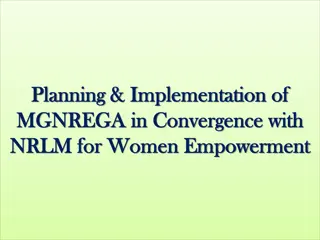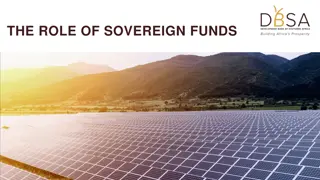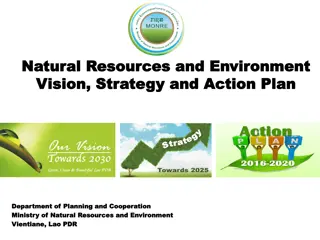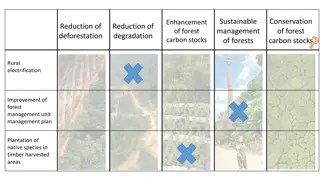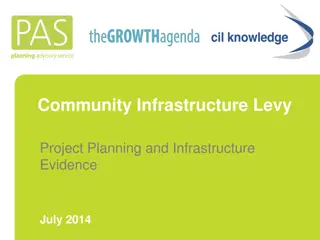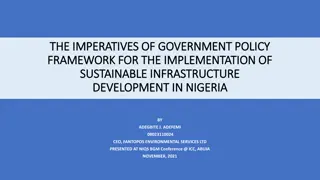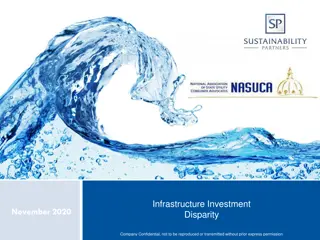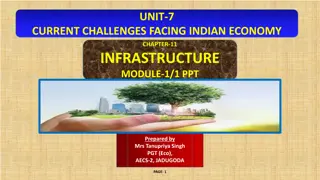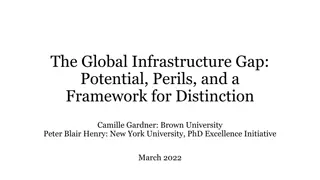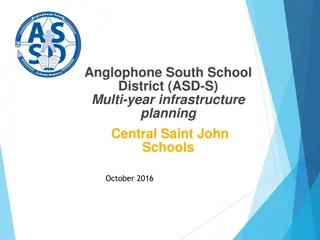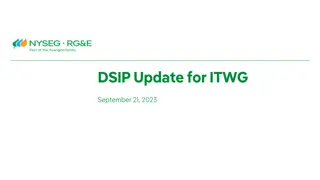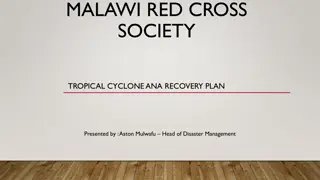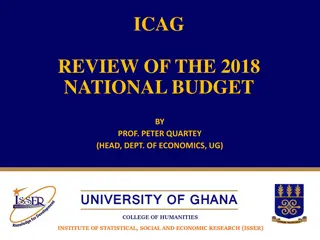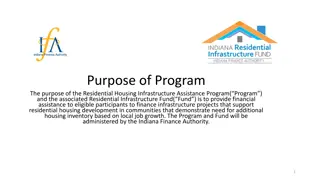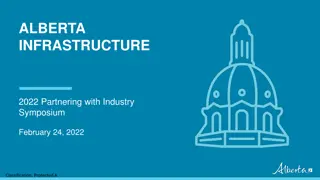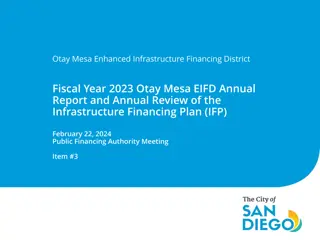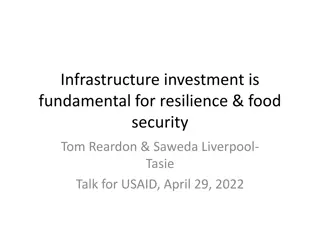Sustainable Infrastructure Planning for Livelihood Enhancement
This project explores the importance of sustainable infrastructure planning in Nigeria to spur economic growth, improve living standards, and create a sustainable livelihood. By analyzing the current infrastructure challenges and proposing strategic scenarios, the aim is to crush poverty, create jobs, and enhance social security through well-thought-out infrastructure development. The focus is on improving economic stability, health standards, education systems, and overall social welfare while minimizing costs and promoting a healthy lifestyle.
Download Presentation

Please find below an Image/Link to download the presentation.
The content on the website is provided AS IS for your information and personal use only. It may not be sold, licensed, or shared on other websites without obtaining consent from the author. Download presentation by click this link. If you encounter any issues during the download, it is possible that the publisher has removed the file from their server.
E N D
Presentation Transcript
SCENARIO INFRASTRUCTURE PLANNING FOR SUSTAINABLE LIVELIHOOD PRESENTED AT THE 2014 WORLD ENGINEERING CONFERENCE ON SUSTAINABLE INFRASTRUCTURE BY OKOLI GABRIEL CHUKWU BABATUNDE AYODEJI EMMANUEL LEMOHA PEACE CHINONYE LAWAL KAMILU OLUWAFEMI INNOCENT CHIBUEZE ATASIE VERE SHABA SUPERVISED BY PROF. C.J AGUNWAMBA ABUJA, NIGERIA
ABSTRACT Infrastructure development and economic growth are mutually reinforcing, as infrastructure development plays a vital role in wealth creation. Infrastructure is at the core of good governance and in turn impacts the standard of living of the people. The condition of infrastructure planning in Nigeria is in a deplorable state and hence good and sustainable infrastructure planning is needed in Nigeria not only to serve as a catalyst for economic growth. In this project scenario infrastructure planning for sustainable livelihood, the current situation of infrastructure in Nigeria was analysed and ways of tackling the challenges identified were projected. Different plausible approaches were analysed using social, technology, economy, environment and political (STEEP) categories of infrastructure as the object for creating planning scenarios. Finally, two different scenarios, 1 and 2 were used applying C54and C53 respectively for the purpose of selecting the best assets combination to plan infrastructure for sustainable livelihood.
CRUSH POVERTY CREATE JOBS MINIMIZE COST OF LIVING PLAN INFRASTRUCTURE TO IMPROVE SOCIAL SECURITY IMPROVE STANDARD OF LIVING CREATE SUSTAINABLE LIVELIHOOD PROMOTE HEALTHY LIFESTYLE INCREASE INCOME
Definition of Key Words: Infrastructure is the basic physical and organizational structure needed for the operation of a society. A livelihood comprises the capabilities, assets (including both material and social resources) and activities required for a means of living. [Robert Chambers and Gordon Conway 1992] A livelihood is sustainable when it can cope with and recover from stresses and shocks, maintain or enhance its capabilities and assets, while not undermining the natural resource base. Scenario planning or scenario analysis is a strategic planning method that some organizations use to make flexible long-term plans.it involves combining history with possibilities to create various imaginary situations that fit our expectation or at least drives towards them.
SYSTEM ANALYSIS Economic stability Improve health standard Employment Good education system entrepreneurship Social welfare Economic instability Unemploymen t Low literacy level Low standard of living Poverty Social disorder
The current situation of infrastructure is analysed with the major drivers of sustainable livelihood in mind. These drivers include but are not limited to Entrepreneurship, Investment, Social security and Social responsibility. ENTREPRENEURSHIP Some small and medium scale businesses that require constant electricity cannot be ventured into due to lack of steady power supply and the option of using self provided energy would make it less profitable. This is also the case with businesses that require 24 hours /day and night run time due to lack of adequate security like CCTV cameras on streets and /or standing security personnel at strategic positions. Some potential entrepreneurs are scared of venturing into agriculture based businesses in remote areas where they have free or cheap land due to the fact that such areas may not accessible either by road, rail or even water transport means coupled with lack of basic social amenities in such places.
INVESTMENT The absence of adequate infrastructure like hard infrastructure as well as government policies to protect and encourage investors both local and foreign is acting as a big barrier to investors who would have jumped into the big market Nigerian population has to offer thereby providing employment opportunities to the teeming unemployed youths. If these infrastructure where to be in place, the story of Nigerian economy would have been a different one. Infrastructures should be planned in such a way that it will serve as encouragement to investors. SOCIAL SECURITY By this, we refer to action programs /measures put in place to ensure access to basic needs such as food, shelter and health care and welfare schemes to the entire population especially the most vulnerable. Provision of social infrastructures like health care /welfare facilities, socio-cultural and youth empowerment will go a long way to creating and sustaining livelihood especially for the most vulnerable like minors and unemployed adults.
SOCIAL RESPONSIBILITY Social responsibilities are obligations citizens owe their communities in order to maintain a balance between the economy and ecosystems. Lack of social Infrastructure may lead to social irresponsibility for example, absence of social security can make an individual feel neglected hence he may choose to react through social disobedience or even violence in most cases. Hence, the availability of social infrastructure will go a long way in reducing crime and social violence. A practical example was the formation of militant groups in oil producing communities when the people felt neglected and marginalized.
E S T E P SOCIAL: ENVIRONMENT: Hazardous waste disposal facilities Material recovering / recycling facilities Drainage system and sewage management facilities TECHNOLOGY: Internet facilities Communication satelite Active postal services Functional rail transport system Traffic management facilities Renewable energy support programmes Health care /welfare facilities Socio-cultural/youth empowerment scheme Educational system Water treatment facilities POLITICAL ECONOMY: Government policies Gas management facilities Specialized coal handling facilities MechanisedAgricultural facilities
SOCIAL INFRASTRUCTURE S Some of the social infrastructures enlisted above like adequate health care facilities, youth empowerment scheme, research and educational facilities etc should be given high priority during infrastructure planning since they directly affect livelihood. We will approach the educational system with a research driven educational system by equipping our institutions and scouting for passionate research scientist especially in areas of energy and communication technologies. This will lead to innovative breakthrough in these areas. In the sphere of health care/welfare facilities, it should be distributed in such a way that it will favour the rural areas as opposed to the norms of having our teaching hospitals and federal medical centers in the urban areas. By so doing, employment opportunities will be created in such areas and hence source of livelihood for the occupants.
TECHNOLOGICAL INFRASTRUCTURE T During infrastructure planning, technological infrastructures such as internet facilities, communication satellite, active postal services, transport facilities, and renewable energy support programmes should be given maximum attention because they are the core hard infrastructures that affect all aspects of human lives. In planning technological infrastructure, we should consider state of art technologies that have being tested and proven to be more economical and robust as well as environmental friendly. For instance, in the internet infrastructure, we should migrate to broad band internet rather than G.S.M as this will be faster and more economical. Such technology will also form a base for ISP (internet service providers) related businesses. As in the case in most developed nations, availability of internet leads to better research, more online based businesses, better awareness. Since knowledge they say is power, awareness means power to the people. In planning transport infrastructure, consideration should be made for demand point and production point to both raw materials and finished goods. Hence, road networks should be planned to connect the various production points to their respective demand points. This also gives good road network to the rural areas where agricultural product which serves as raw materials for so many processing industries are based.
T Effective and time oriented mass transit scheme will encourage using mass transport rather than private vehicles and this will reduce traffic congestion and gas emissions, thereby improving general standard of living. A practical example can be seen in Lagos where many now prefer public transport which has a dedicated lane to their private vehicle in other to avoid the heavy traffic the city is known for. Planning for functional rail system will ease the movement of materials like cements, rods, and reduce the amount of heavy trucks on the road hence reduces the road maintenance cost and improving transportation in the general sense. These functional rail systems will encourage people to invest in rail transportation thus creating jobs for sustaining livelihood.
T GLOCAL: Think Global , Act Local Our keyword for energy will be GLOCAL, this is the combination of two words (global and local), we want to think global but act local in our energy planning, what this means is that we implement the global state of art technologies using our locally available resources in the provision of renewable energy for our communities. We can have a 10 year plan on renewable energy. The first step of this plan will be selecting a group of bright indigenous engineers who will be sent to developed nations for research based training in different areas of renewable energy like solar, wind and biomass to acquire the state of art technology in those areas and then return home for stage two of the program which is using our locally available resource to implement this technologies this we think we go a long way in solving energy challenges.
E ECONOMIC INFRASTRUCTURE The economy of our case study (Nigeria) is highly dependent on oil and gas and as a result, 100% accuracy is required for planning the infrastructure of this sector. In other to maximize its output, plan should be made to reduce gas flaring and wasting of crude by-product this can be achieved by establishing functional gas management facilities to enable use of these gases both in power productions and other areas. Crude by-product processing plant should not be left out in the planning. The benefits of these management facilities include job creation, economic growth, income generation and so on. However, our planning should encourage economic diversity hence; mechanized agriculture should be giving a chance through provision of realistic agric-loan, subsidizing of agricultural raw materials and equipment, providing training facilities for mechanized agriculture. This will not only provide entrepreneurship opportunity and employment opportunities but will also contribute immensely towards the achievement of millennium goal of availability of food for all.
ENVIRONMENTAL INFRASTRUCTURE E Lack of proper drainage systems is posing a lot of hazards especially during raining season on our roads. Improper sewage management is also one of the major health challenges we are facing in our environment. Solid waste management and recycling facilities are not in best condition at the moment. These challenges should be considered during infrastructure planning, proper drainage system should be implemented however; our main focus here will be on solid waste management and recycling, we propose a plan where solid waste collection, sorting and recycling facilities should be put in place. Refurbishing centers should be encouraged to take of electronics waste these will promote indigenous knowledge of this electronics, will provide jobs at both semi skill and skilled labour level, it will also make this electronics and other recyclable product affordable thereby reducing cost of living and promoting standard of living. But for the environmental implications, our energy planning would have considered nuclear plant which serves as a large source of energy. However, for sustainable livelihood we consider human safety first and until we are sure of a proper means of disposing nuclear waste, we will continue to look at that as a research area only. Beautification of environment with facilities like natural parks for relaxation should be part of our plan. forestation should be encouraged to curb global warming as well as promote ecological cycle
POLITICAL INFRASTRUCTURE P The major political challenge we have is government policies and regulations. In planning infrastructure, government policies should be made to encourage investors and the implementation of already existing government policies should be done without compromise. This can be achieved by minimizing human factors in the implementation. An example of this is implementing an automated environmental pollution control system like the Nature Technogenic technology which is a technology for regulating industrial gas discharge automatically. One of the important policies that should be modified implemented is the local content policies. We propose a policy where every expatriate will engage in the country will have an indigenous engineer attached to him and such expatriate will be under obligation to transfer the technical knowhow to the attached indigenous engineer within a stipulated time depending on the complexity of the skill, this will increase the volume of indigenous knowhow and reduce our expenses on foreign expatriates thereby promoting local content. Government policies should encourage employment of indigenous engineers through tax by levying higher tax on the expatriate and low tax on the indigenous engineers.
Weights Of Infrastructure Categories As Assets Of Sustainable Livelihood S/No. Approach Weight/Importance 1 Social 10 points 2 Technological 7 points 3 Economy 6 points 4 Environment 8 points 5 Political 4 points Here, we allocated weights to different categories of infrastructure we hope to plan based on their contributions to sustainable livelihood. We choose weight points of 10 and 1 as maximum and minimum values respectively. We allocated the maximum point to social infrastructure because it is livelihood itself as it contains the basic needs of man, thus its total availability will result to a sustainable livelihood. Hence, social infrastructure was used as the control.
SCENARIO 1 S(Social) T(Technological) E(Economy) E(Environment) P(Political) TOTAL 35 31 29 28 27 25 4 8 4 8 4 4 4 8 6 8 6 6 8 7 7 7 7 6 6 10 10 10 10 10 7 0 0 0 0 0 0 0 0 0 0 0 0 0 0 0 0 0 0 0 0 1 2 3 4 5 6 7 8 9 10 11 SCENARIO 1 : COMBINATION OF FOUR ASSETS IN PLANNING S(Social) T(Technological) 10 7 S 10 S T 10 7 S T 10 7 S T 10 7 T 7 E(Economy) 6 E 6 E 6 E 6 E 6 E(Environment) 8 E 8 E 8 E 8 E 8 P(Political) 4 P 4 P 4 P 4 P 4 TOTAL 35 25 28 29 27 31
SCENARIO 2 S (Social) T (Technological) E (Economy) E (Environment) P (Political) TOTAL 35 25 24 23 4 22 21 21 20 19 8 18 17 8 6 6 4 8 4 4 4 8 4 4 8 7 7 7 7 6 6 8 6 6 8 10 10 10 10 10 10 10 7 7 7 6 0 0 0 2 0 0 0 4 0 0 0 6 0 0 0 8 0 0 0 0 0 0 0 0 0 0 0 0 0 0 0 0 0 0 1 3 5 7 9 10 11 12 13 14 15 16 17 18 19 20 21 SCENARIO 2: COMBINATION OF THREE ASSETS IN PLANNING S (Social) T (Technological) E (Economy) E (Environment) P (Political) TOTAL 10 7 S T 10 7 S T 10 7 S T 10 7 S 10 S 10 S 10 T 7 T 7 T 7 6 8 E 6 E 6 E E 6 8 E 6 E E 6 8 E E 6 8 E 8 E 8 E 8 4 35 P 4 P 4 P 4 P 4 P 4 P 4 23 25 21 20 22 24 17 19 21 18
CONCLUSION This project was able to identify the major connection of infrastructure and livelihood, infrastructure can help job creation and general well being of the people and their environment thereby creating livelihood and making it sustainable . how a well planned It proposes infrastructure planning method for sustainable livelihood. Based on the results obtained, we recommend the best combination from scenario 1 for infrastructure planning in Nigeria and other developing countries. However, when this assets are not within reach, best result of scenario 2 atleast should be implemented.




